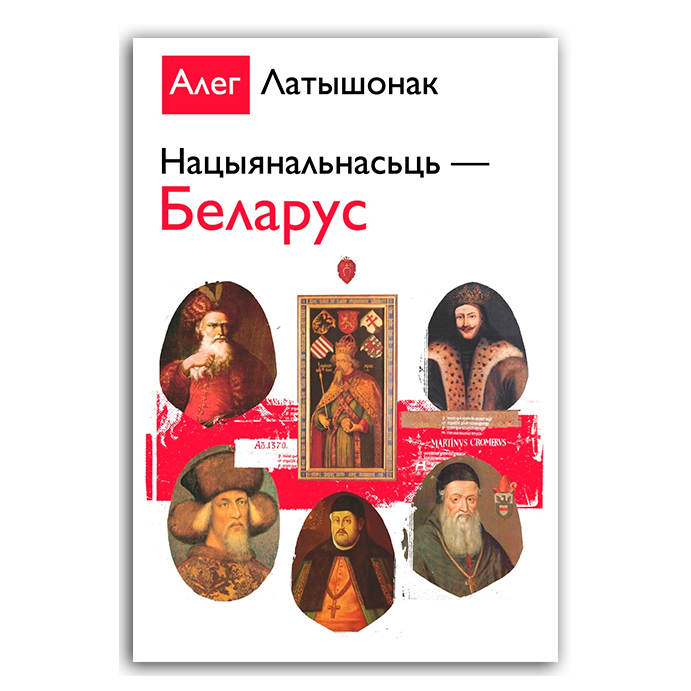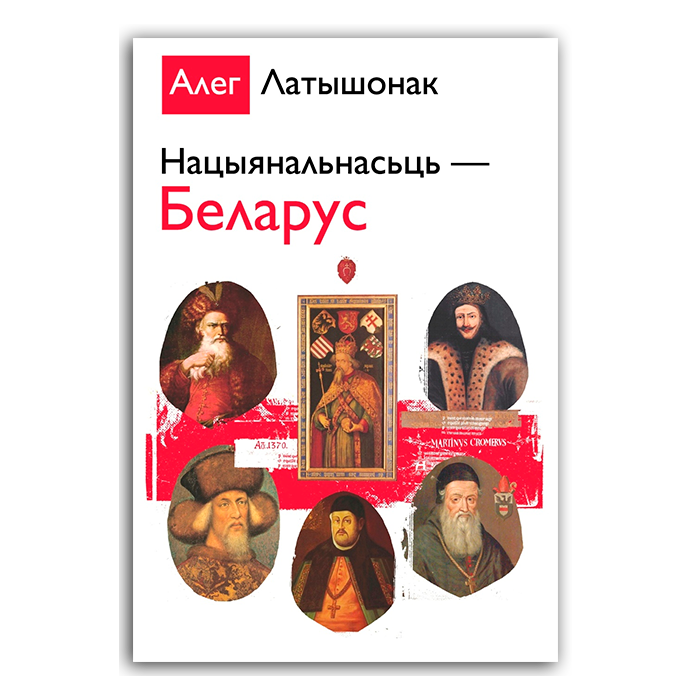Інбелкульт
Nationality — Belarusian
Nationality — Belarusian
Аўтар: Oleg Latishonok
Low stock: 2 left
Couldn't load pickup availability
Мова: Belarusian
Старонак: 720
Год выдання: 2017
Месца выдання: Smolensk
Вокладка: soft
Фармат: 16.5x23.5 cm
ISBN: 978-5-00076-018-5
The book by the Belarusian historian from Bialystok brings together under one cover the main works he wrote, dealing with various issues of Belarusian history from ancient times to almost the present day. As the author himself notes in the preface, he has long been troubled by the question "Where did the Belarusian land come from?", and in most of the texts in this edition he seeks to answer it. The bulk of the book is occupied by the fundamental work "From the White Ruthenians to the Belarusians: at the origins of the Belarusian national idea", which was the author's habilitation work, was published in Polish in 2007 and is being reprinted in Belarusian for the first time in this edition. The rest of the book consists of articles of various lengths and genres, devoted to the Norman factor in the ancient history of Belarus, to individual aspects of Belarusian history during its time as part of the Grand Duchy of Lithuania, to the emergence of a conscious Belarusian idea in the 19th century, to some problems of its further development, etc.
CONTENTS
A word to the Belarusian reader……………………………………………………………………………………….. 10
I. Polotsk and the newcomers “from across the sea”
Normans in the history of Belarus……………………………………………………………………………………….. 16
The “Saga” about Rogvald. To the Norman origin of Rogvald……………………………… 22
Saxo Grammaticus, the legendary Danes' campaigns on the Dvina
in the 19th century and the beginning of the Polotsk Principality……………………………………………………… 32
The most unusual book about the history of Belarus that I have read……………………… 46
New discovery about Vseslav the Sorcerer……………………………………………………………………….. 48
Vladimir Volodarovich Minsky — Rex Woldemar……………………………………………………….. 49
Iben Fonnesberg-Schmidt, Papieże i krucjaty bałtyckie 1147-1254,
Warszawa, 2009, ss. 264……………………………………………………………………………………. 51
II. The Birth of White Russia
Were there already Belarusians in the 11th century?……………………………………………………………………… 60
When was Belarus founded?………………………………………………………………………………………………. 62
From White Ruthenians to Belarusians: at the origins of the Belarusian national idea……………… 64
Introduction …………………………………………………………………………………………………………………… 64
Chapter I. Medieval references to “White Rus” and “White Ruthenians”………………. 70
Historians and linguists on the origin of the name “White Rus”………………………. 70
The first mentions of “White Rus” and “White Ruthenians”
in the “Description of the Lands” and “Life of St. King”………………………………………………………. 76
“Land of the White Ruthenians” in the Dubnitsa Chronicle………………………………………………. 88
“White Ruthenians” in the poems of Peter Zuchenwirth……………………………………………… 89
“Black Ruthenians” and “White Ruthenians” in the chronicles of Henry of Mugeln…………….. 91
“White Russia” in the chronicle of Yan of Chernkov……………………………………………………………… 92
“White Rus” and “White Ruthenians” in correspondence
Grand Masters of the Teutonic Order……………………………………………………….. 93
The first Russian triad: “true, white and red Ruthenians”
in the chronicle of the Council of Constance by Ulrich Richenthal……………………………… 96
Classic color triad - "White Russia", "Black"
and “Red” — on Fra Mauro’s world map……………………………………………….. 101
The first mentions of “White Rus” in Russian literature………………………. 102
Chapter II. Polish writers about “White Rus”……………………………………………….. 114
Chapter III. From “Lithuania and Rus” to “Lithuania and White Rus”………………………………………. 137
Geographical and historical regions of the Grand Duchy of Lithuania
in the eyes of the natives in the 16th - early 17th centuries………………………………………………. 137
“Lithuanians” and “Ruthenians”, “Lithuania” and “Rus”……………………………………………………………… 146
The first “Belarusian”. Solomon Rysinski……………………………………………………………………… 151
Ruthenians about “White Russia”. End of the 16th - middle of the 17th century……………………………… 156
National self-awareness of the inhabitants of “Lithuania and White Russia”……………………… 165
Chapter IV. “White Rus”, “Little Rus” and “Great Rus”……………………………….. 176
“White Russia” and “Belarusians” in Moscow writing……………………………………….. 176
“Little Russia”, or “Little Russia”……………………………………………………………………… 183
White Russia during the Khmelnytsky Uprising……………………………………………………….. 197
Chapter V. The Time of Belarusian Colonels 1654—1667……………………………………….. 203
Belarusian Colonel Konstantin Poklonsky………………………………………………………. 203
The Tsar's official acceptance of the title "Sovereign of White Russia"
and the political consequences of this step………………………………………………………………………. 214
Belarusian Colonels Ivan Nechay and Dzianis Murashka……………………………………… 219
“White Russia” during the Muscovite War and the Swedish “flood”………………………. 224
Chapter VI. The Century After the Catastrophe………………………………………………………. 235
Chapter VII. White Russia - a land without history……………………………………………………… 257
Ending……………………………………………………………………………………………………………….. 285
Bibliography……………………………………………………………………………………………………………….. 291
List of abbreviations………………………………………………………………………………………………. 305
Identification of the person of fratris Vaislani from the “Description of the Lands”……………………………………… 306
Kreva — Verkh — Belaya Rus………………………………………………………………………………………. 309
Joachim of Flörs, Gog of the Land of Magog and White Russia……………………………………………………….. 316
State roots of the Republic of Belarus………………………………………………………………………. 331
Two Souls of a Nation……………………………………………………………………………………………………… 335
III. In European Sarmatia
The futile efforts of academic historians……………………………………………………………………… 340
The Early Medieval Principality of Grodno in Historiography
the last twenty years……………………………………………………………………………………… 359
Brest-Draghichyn land in the 10th-13th centuries.
in the light of recent research……………………………………………………………………….. 371
Fantastic Empire………………………………………………………………………………………………………. 380
Students from the Grand Duchy of Lithuania before the rector's court
The University of Krakow in 1469—1536……………………………………………………….. 387
Polyamon. Legend codes……………………………………………………………………………………………….. 392
Legend……………………………………………………………………………………………………………………. 392
First code………………………………………………………………………………………………………………. 393
The important “opposite”………………………………………………………………………………………………………. 393
Hand of Gastout………………………………………………………………………………………………………. 394
Palaemon lived in Turkey………………………………………………………………………………………………. 396
The Genius of Manipulation……………………………………………………………………………………… 397
Samogitian fable……………………………………………………………………………………………….. 398
Hungarian-Belarusian relations in the Middle Ages and early modern times ………………… 400
Kalman, Hungarian “King of the White Ruthenians”……………………………………………………………….. 402
Lajas the Great in the “land of the White Ruthenians”……………………………………………………………… 405
The Double Cross - a Hungarian symbol of Belarusian nationalists?……………………………… 407
Treaty of Radnotsk 1656……………………………………………………………………………………… 408
Saint America of Hungary - the true patron saint of Grodno?………………………………………………. 411
The wars of Lithuania with Moscow in the early 16th century as a factor in changes in the ethnic composition
identification in Eastern Europe……………………………………………………………………….. 417
IV. The formation of the modern Belarusian nation
To the periodization of the history of Belarus in the era of modernization………………………………………. 430
From the history of the Grand Duchy of Lithuania to the history of Belarus………………………………. 442
Belarusian Enlightenment………………………………………………………………………………………………. 449
The Union and the Belarusian national movement from the mid-18th century
until the middle of the 20th century……………………………………………………………………………….. 457
Our Kosciuszko was glorious……………………………………………………………………………………… 469
The Birth of the Belarusian National Idea……………………………………………………………………….. 472
Belarusian national idea……………………………………………………………………………………….. 477
In the beginning was the word……………………………………………………………………………………………… 482
Eugeniusz Mironowicz. Białorusini w Polsce, 1944-1949. Warszawa, 1993. S. 219. ….. 491
The Myth of Literary Beginners………………………………………………………………………………. 495
Conversation between “church elder Yanka” and “Jasko, the landlord from near Vilnius” …………. 501
Stories in Byelorussian dialect………………………………………………………………………… 507
Who were our oldest grandfathers and what was their fate before the Union?………………. 507
Did we do well by leaving the Union?……………………………………………………………… 511
A big mistake of our Belarusians……………………………………………………………….. 513
A conversation at the cemetery of the headman Yanko with his brother Khvedosem…………………… 514
A fairy tale is not a fairy tale, it was not, but it happens……………………………………. 516
In Vaiskaya on the 200th anniversary of the birth of Plakid Jankowski……………………… 518
Nationality and “Western Russianism”. Ideologicalized locality………………………………. 521
The myth of the “locals”………………………………………………………………………………………………………. 525
The Belarusian question in the period of the "post-Sevastopol spring"
and the uprising of 1863-1864………………………………………………………………………………………. 534
The uprising of 1863-1864 in Belarus in the context of international politics
The case of Colonel Alexander Lyankevich “Lander”………………………………………. 540
Rebels,
guerrillas………………………………………………………………………………………………
545
Nationality of Maciej Buraček……………………………………………………………………………… 547
Herman Breger, Khatsiukhova: The Story of a Small Settlement,
ed. “Belarusian Book Collection”. Minsk, 2001, p. 240……………………………………………………… 551
Ippolit Kraskovsky — a “Western Russian” writer from the Białystok region……………………… 552
Kraskovian, or Evening Conversations at the Rectory in Dubičy–Tserkovne
at the beginning of the 20th century……………………………………………………………………………………….. 554
Refugee …………………………………………………………………………………………………………………. 556
Radziwill of Zawiszy (Krasinskaya) Maria Magdalena (1861—1945) ………………………….. 557
Jerzy Turonek, Wacław Iwanowski i odrodzenie Białorusi, Warszawa 1992,
Warszawska Oficyna Wydawnicza “Gryf”, Instytut Historii PAN, ss. 160……………… 560
Belarusians
and Masons………………………………………………………………………………………………………..
564
Belarusian politicians and Protestants. ………………………………………………………………………… 569
Children from Plutich………………………………………………………………………………………………………………. 573
Generation,
whose
did not become………………………………………………………………………………………
575
How Professor Soudal discovered America……………………………………………………………………………….. 577
September of Dissent………………………………………………………………………………………………………. 579
Jan Zaprudnik, Belarus: At a Crossroads in History, Boulder —
San Francisco - Oxford 1993. ………………………………………………………………………….. 581
History of Belarus in demography……………………………………………………………………………………….. 583
Mikola Yermalovich (1921—2000)……………………………………………………………………………….. 586
The country of Belarus has existed since the 16th century……………………………………………………………………….. 588
The fate of a nation cannot depend on one person……………………………………………………… 596
My ranking of European nations at the beginning of the 21st century……………………………… 599
V. Civilization and Geopolitics
Belarusian nationalism and the clash of civilizations……………………………………………………….. 620
Huntington, time-tested. Belarus and the post-Soviet countries
in the conflict of civilizations……………………………………………………………………………………….. 628
Polish Turan: Belarus, Lithuania and Ukraine in the views of Felix Konechny………………. 634
The Geopolitics of Orthodoxy……………………………………………………………………………………………….. 650
The Belarusian-Polish state border in the light of civilizational theories…………… 652
The long return to Polotsk………………………………………………………………………………………. 668
Nominal index …………………………………………………………………………………………………………. 672
Geographical index ………………………………………………………………………………………… 699


